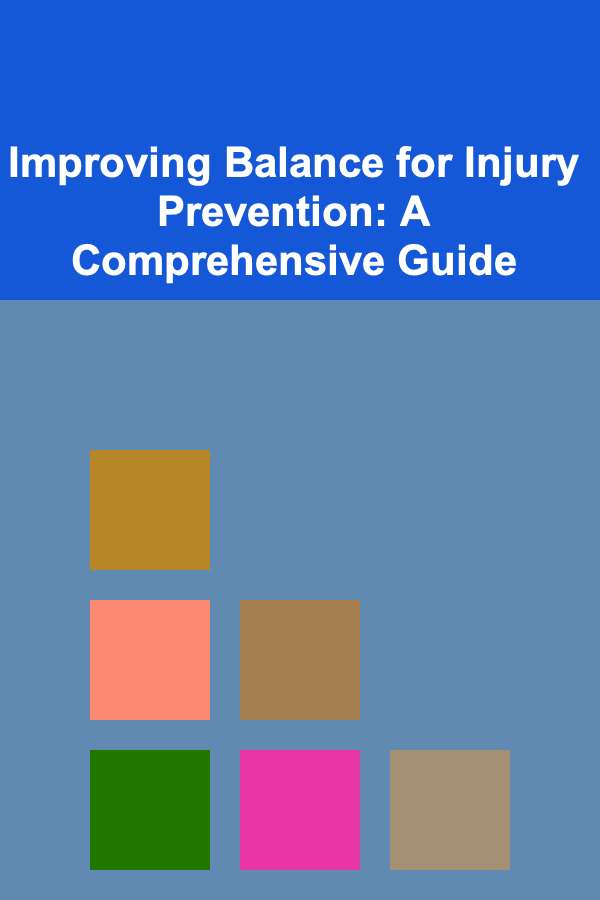
Improving Balance for Injury Prevention: A Comprehensive Guide
ebook include PDF & Audio bundle (Micro Guide)
$12.99$11.99
Limited Time Offer! Order within the next:

Balance, often taken for granted, is a fundamental component of physical function and overall well-being. It's the ability to maintain your center of gravity within your base of support, allowing you to stand, walk, run, and perform daily activities with stability and control. Poor balance significantly increases the risk of falls and injuries, particularly among older adults, athletes, and individuals with certain medical conditions. This guide provides a comprehensive overview of balance, the factors that influence it, and practical strategies to improve your balance for injury prevention.
Understanding the Science of Balance
Balance is a complex interplay of several systems working together. These systems include:
- The Vestibular System: Located in the inner ear, this system detects changes in head position and movement. It sends signals to the brain to help maintain equilibrium.
- Proprioception: This is your body's sense of its position in space. Proprioceptors, specialized sensory receptors in muscles, tendons, and joints, provide information about body part location, movement, and force. It's like knowing where your arm is even with your eyes closed.
- Vision: Your eyes provide crucial information about your environment, helping you orient yourself and maintain stability.
- The Central Nervous System (CNS): The brain and spinal cord process information from the vestibular system, proprioceptors, and vision, coordinating muscle responses to maintain balance.
- Musculoskeletal System: Strong muscles, especially in the legs, core, and ankles, are essential for supporting the body and making necessary adjustments to maintain balance.
When these systems function harmoniously, you maintain excellent balance. However, disruptions or impairments in any of these systems can lead to balance problems and an increased risk of falls.
Factors Affecting Balance
Numerous factors can negatively impact your balance. Understanding these factors is crucial for identifying potential risks and developing targeted strategies for improvement.
Age
As we age, several age-related changes can affect balance. These include:
- Decreased Muscle Strength and Mass: Sarcopenia, the age-related loss of muscle mass, weakens the muscles needed to maintain stability.
- Reduced Proprioception: The sensitivity of proprioceptors can decline with age, making it harder to sense body position.
- Vision Changes: Conditions like cataracts or macular degeneration can impair vision, affecting the ability to orient oneself and maintain balance.
- Vestibular System Decline: The function of the vestibular system can gradually decline with age, leading to dizziness and balance problems.
- Slower Reaction Time: The nervous system's ability to react quickly to changes in balance can slow down with age, increasing the risk of falls.
Medical Conditions
Certain medical conditions can significantly impair balance. Some common examples include:
- Neurological Disorders: Conditions like Parkinson's disease, multiple sclerosis, and stroke can damage the brain and nervous system, affecting balance and coordination.
- Inner Ear Disorders: Conditions like vertigo, Meniere's disease, and labyrinthitis can disrupt the vestibular system, causing dizziness and balance problems.
- Arthritis: Arthritis in the knees, hips, or ankles can cause pain and stiffness, limiting mobility and affecting balance.
- Peripheral Neuropathy: Damage to the nerves in the feet and legs can reduce proprioception, making it difficult to sense foot position and maintain balance.
- Cardiovascular Conditions: Conditions like low blood pressure or heart arrhythmias can cause dizziness and fainting, increasing the risk of falls.
Medications
Certain medications can have side effects that impair balance. These include:
- Sedatives: These medications can cause drowsiness and dizziness, affecting balance and coordination.
- Antidepressants: Some antidepressants can cause dizziness and lightheadedness, increasing the risk of falls.
- Antihypertensives: These medications can lower blood pressure, which can sometimes lead to dizziness and fainting.
- Diuretics: These medications can cause dehydration, which can lead to dizziness and lightheadedness.
- Muscle Relaxants: These can reduce muscle strength and coordination.
Lifestyle Factors
Lifestyle factors can also play a role in balance. These include:
- Inactivity: A sedentary lifestyle can lead to muscle weakness and reduced proprioception, affecting balance.
- Poor Nutrition: Nutrient deficiencies, such as vitamin D deficiency, can affect muscle strength and bone health, increasing the risk of falls.
- Alcohol Consumption: Alcohol can impair balance and coordination, increasing the risk of falls.
- Lack of Sleep: Sleep deprivation can affect cognitive function and reaction time, increasing the risk of falls.
- Footwear: Improper footwear, like high heels or shoes with poor support, can negatively impact balance.
Assessing Your Balance
Before embarking on a balance improvement program, it's essential to assess your current balance abilities. This will help you identify areas where you need to focus and track your progress over time. There are several simple tests you can perform at home or with the assistance of a healthcare professional.
The Romberg Test
This test assesses your ability to maintain balance with your eyes closed, relying on proprioception and the vestibular system.
- Stand with your feet together, arms at your sides.
- Focus on a fixed point in front of you.
- Close your eyes and maintain your balance for 30 seconds.
Difficulty maintaining balance with your eyes closed may indicate a problem with proprioception or the vestibular system.
The Single Leg Stance Test
This test assesses your ability to maintain balance on one leg.
- Stand with your feet together, arms at your sides.
- Raise one leg off the ground, keeping your knee bent.
- Maintain your balance for as long as possible, up to 30 seconds.
- Repeat on the other leg.
Inability to maintain balance for at least 5 seconds on each leg may indicate a balance deficit.
The Tandem Gait Test
This test assesses your ability to walk in a straight line with one foot directly in front of the other.
- Walk along a straight line, placing one foot directly in front of the other, heel to toe.
- Repeat for a distance of 10 feet.
Difficulty walking in a straight line may indicate a balance problem.
Consulting a Healthcare Professional
If you have concerns about your balance, or if you have a history of falls, it's essential to consult with a healthcare professional. A physical therapist, occupational therapist, or physician can perform a more comprehensive balance assessment and recommend appropriate interventions.
Strategies to Improve Balance and Prevent Injuries
Improving your balance requires a multifaceted approach that addresses the underlying factors contributing to balance problems. Here are some effective strategies:
Balance Exercises
Balance exercises challenge your stability and help improve the coordination of the systems involved in balance. Start slowly and gradually increase the difficulty as you progress. It's recommended to perform these exercises in a safe environment, such as near a wall or with someone nearby for support.
- Weight Shifting: Stand with your feet shoulder-width apart. Shift your weight from side to side, then forward and backward.
- Example: Imagine you are a pendulum, gently swaying from side to side and then forward and back.
- Single Leg Stance: Stand on one leg for as long as possible, gradually increasing the duration.
- Example: Try performing this while brushing your teeth or waiting in line.
- Tandem Stance: Stand with one foot directly in front of the other, heel to toe.
- Example: Start by holding onto a chair for support and gradually decrease the amount of support as your balance improves.
- Heel Raises and Toe Raises: Stand with your feet flat on the ground. Raise up onto your toes, then lower back down. Then, lift your toes off the ground, balancing on your heels.
- Example: Perform these exercises while watching TV or listening to music.
- Walking Heel-to-Toe: Walk in a straight line, placing one foot directly in front of the other, heel to toe.
- Example: Visualize walking on a tightrope to help maintain your focus and balance.
- Tai Chi: This gentle exercise combines slow, flowing movements with deep breathing, improving balance, coordination, and flexibility.
- Example: Look for a local Tai Chi class or follow a Tai Chi video online.
- Yoga: Many yoga poses challenge balance and improve proprioception.
- Example: Try tree pose, warrior poses, or balancing table pose.
- Wobble Board or Balance Disc: These devices provide an unstable surface that challenges your balance.
- Example: Start by using the board near a wall or chair for support.
Important Tip: Start with exercises that are easy for you and gradually increase the difficulty as your balance improves. Listen to your body and stop if you feel pain.
Strength Training
Strengthening the muscles that support your body is essential for maintaining balance. Focus on strengthening your legs, core, and ankles.
- Squats: Stand with your feet shoulder-width apart. Lower your hips as if you're sitting in a chair, keeping your back straight.
- Example: Imagine you are sitting down onto a box.
- Lunges: Step forward with one leg and lower your body until your front knee is bent at a 90-degree angle.
- Example: Keep your front knee behind your toes.
- Calf Raises: Stand with your feet flat on the ground. Raise up onto your toes.
- Example: Perform these while holding onto a counter for support if needed.
- Hamstring Curls: Stand with your feet flat on the ground. Bend one knee and lift your heel towards your buttocks.
- Example: Use a resistance band to increase the challenge.
- Core Strengthening Exercises: Planks, bridges, and abdominal crunches can help strengthen your core muscles, which are essential for stability.
- Example: Start with holding a plank for 30 seconds and gradually increase the duration as you get stronger.
Flexibility Exercises
Improving flexibility can improve your range of motion and reduce the risk of muscle strains and injuries, both of which can impact balance.
- Stretching: Regularly stretch your muscles, especially your hamstrings, calves, and hip flexors.
- Example: Hold each stretch for 30 seconds.
- Yoga and Pilates: These activities can improve flexibility, strength, and balance.
- Example: Look for beginner-friendly classes or videos.
Vision Correction
If you have vision problems, ensure you have appropriate vision correction, such as glasses or contact lenses. Regular eye exams are crucial for detecting and addressing vision issues that can affect balance.
Proper Footwear
Wear shoes that provide good support and stability. Avoid high heels or shoes with slippery soles. Ensure your shoes fit properly and are in good condition.
Home Safety Modifications
Making modifications to your home can significantly reduce the risk of falls.
- Remove tripping hazards: Clear clutter, loose rugs, and cords from walkways.
- Install grab bars: Install grab bars in the bathroom, especially near the toilet and shower.
- Improve lighting: Ensure adequate lighting throughout your home, especially in hallways and stairways.
- Use assistive devices: Use a cane or walker if needed for added support.
- Secure rugs: Use non-slip pads under rugs to prevent them from slipping.
Nutrition and Hydration
Maintaining a healthy diet and staying hydrated are crucial for overall health and balance.
- Vitamin D: Vitamin D is essential for muscle strength and bone health. Get enough vitamin D through sunlight, diet, or supplements.
- Calcium: Calcium is important for bone health. Ensure you get enough calcium through diet or supplements.
- Hydration: Dehydration can lead to dizziness and lightheadedness. Drink plenty of water throughout the day.
Medication Review
Talk to your doctor about your medications and their potential side effects on balance. They may be able to adjust your dosage or recommend alternative medications.
Regular Check-ups
Regular check-ups with your doctor can help identify and address underlying medical conditions that may be affecting your balance. Discuss any concerns you have about your balance with your doctor.
Managing Underlying Conditions
Effectively manage any underlying medical conditions that may be contributing to your balance problems. Work with your doctor to develop a treatment plan that addresses your specific needs.
Staying Active
Regular physical activity is crucial for maintaining balance and preventing falls. Engage in activities that you enjoy and that challenge your balance, such as walking, dancing, or gardening.
Mindfulness and Body Awareness
Practicing mindfulness and body awareness can help you improve your proprioception and balance. Focus on your body's position in space and pay attention to any sensations of imbalance. Meditation, deep breathing exercises, and body scan exercises can all help improve mindfulness and body awareness.
Consistency is Key
Improving balance takes time and consistent effort. Be patient with yourself and gradually increase the difficulty of your exercises as you progress. Make balance exercises a regular part of your routine to maintain your gains and prevent future falls. Aim for at least 30 minutes of balance exercises, three times per week.
Conclusion
Improving your balance is a proactive step you can take to prevent injuries, enhance your physical function, and improve your overall quality of life. By understanding the factors that influence balance, assessing your current abilities, and implementing the strategies outlined in this guide, you can significantly reduce your risk of falls and maintain your independence for years to come. Remember to consult with a healthcare professional if you have any concerns about your balance or if you have a history of falls. Prioritizing balance is an investment in your long-term health and well-being.
Reading More From Our Other Websites
- [Home Maintenance 101] How to Identify and Fix Leaks in Your Appliances
- [Stamp Making Tip 101] Creative Stamp-Making Techniques: Carving, Laser Cutting, and 3D Printing
- [Personal Finance Management 101] How to Avoid Common Financial Scams and Frauds
- [Gardening 101] Best Plant Pairings for a Successful Companion Planting Garden
- [Personal Finance Management 101] How to Set Up an Automatic Savings Plan for Easy Growth
- [Personal Investment 101] How to Invest in Real Estate Without Owning Property
- [Home Budget Decorating 101] How to Decorate Your Home with Minimalist Style for Less
- [Weaving Tip 101] The Tapestry of Tales: How Ancient Weaving Motifs Shape Contemporary Book Aesthetics
- [Skydiving Tip 101] Corporate Team-Building at Altitude: Skydiving as the Ultimate Business Retreat
- [Organization Tip 101] How to Create a Mindfulness Corner in Your Home

How to Use Bulletin Boards for Volunteer Updates
Read More
How to Market Your Blockchain Project to a Global Audience
Read More
Prioritizing Goals Over Tasks: A Deep Dive
Read More
How to Build a Daily Health To-Do List for Optimal Energy
Read More
10 Tips for Senior Pet Dental Care
Read More
10 Tips for Dealing with Last-Minute Doctor Appointment Changes
Read MoreOther Products

How to Use Bulletin Boards for Volunteer Updates
Read More
How to Market Your Blockchain Project to a Global Audience
Read More
Prioritizing Goals Over Tasks: A Deep Dive
Read More
How to Build a Daily Health To-Do List for Optimal Energy
Read More
10 Tips for Senior Pet Dental Care
Read More